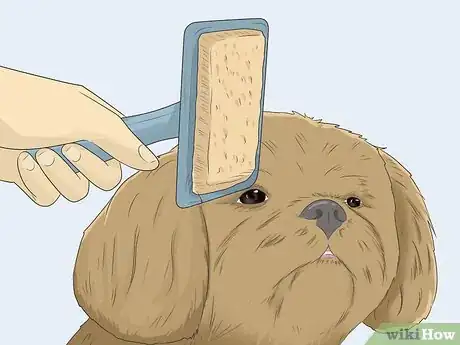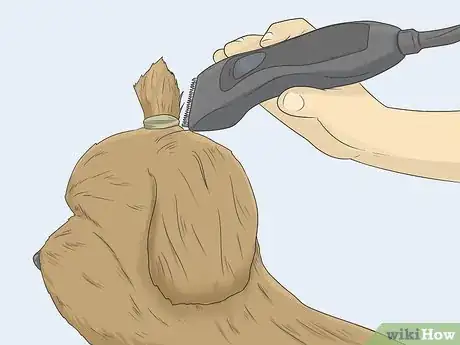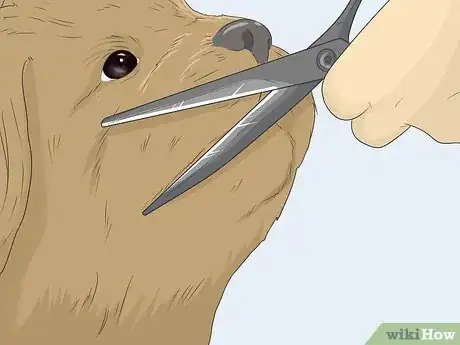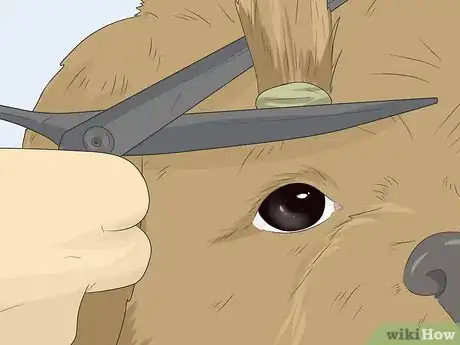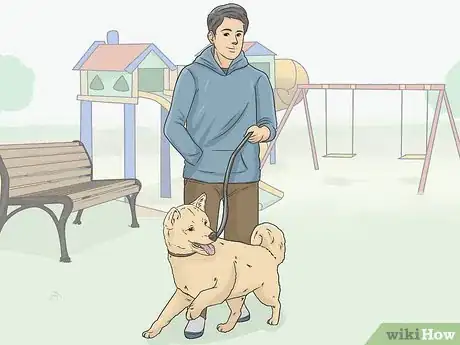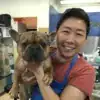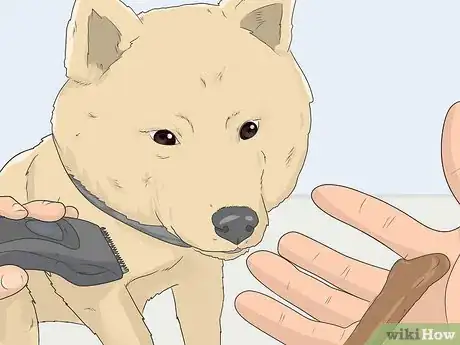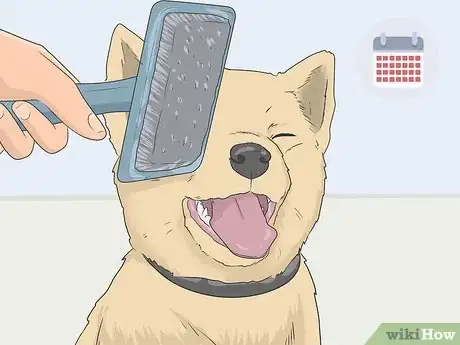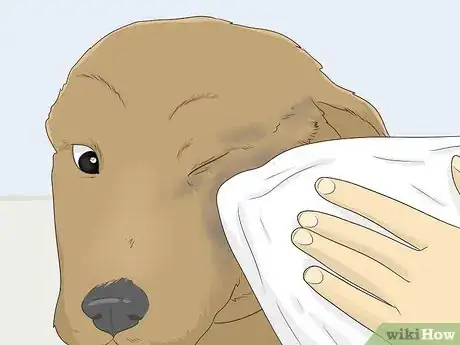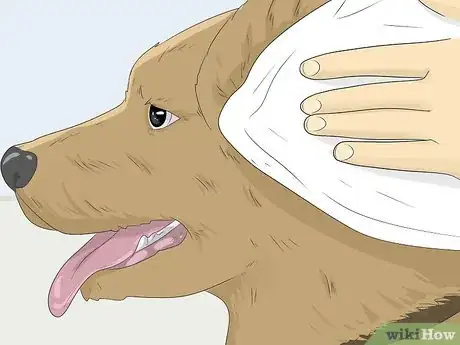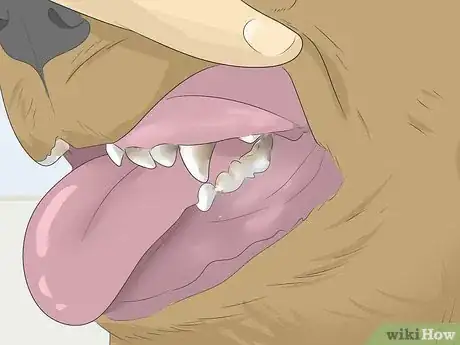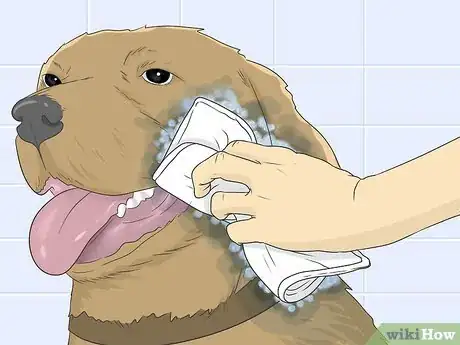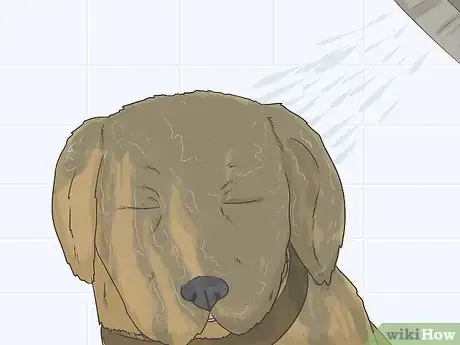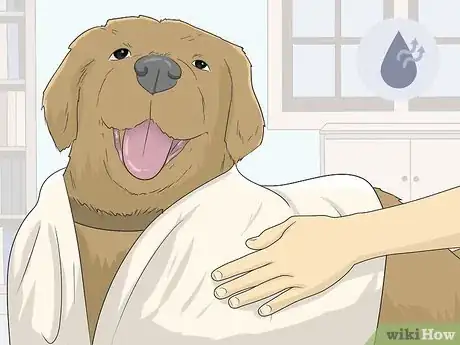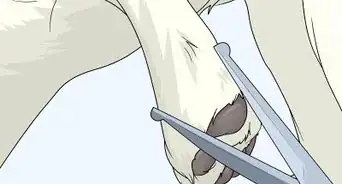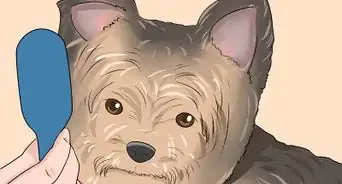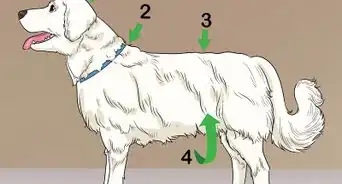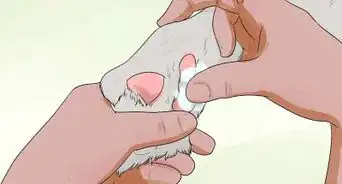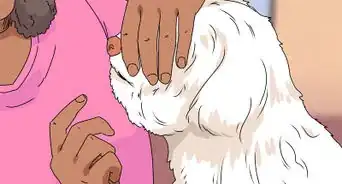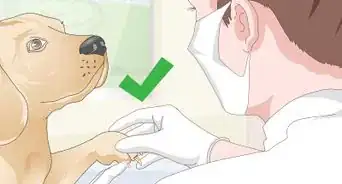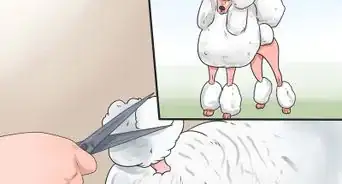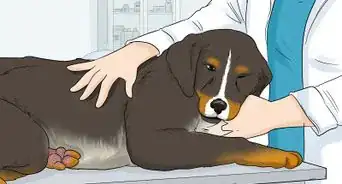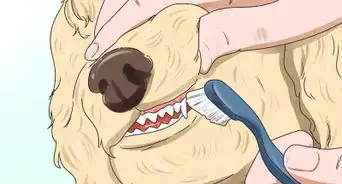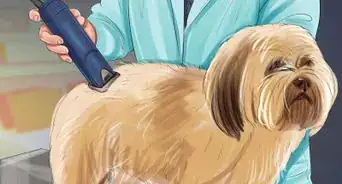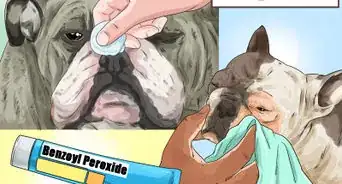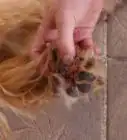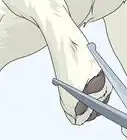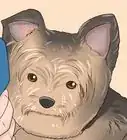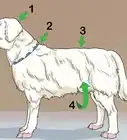This article was co-authored by Lancy Woo. Lancy Woo is a Certified Pet Groomer and the Owner of VIP Grooming, a pet grooming salon based in San Francisco, California. VIP Grooming has served San Francisco for over 35 years. Lancy received her pet grooming certification from the WWPSA (Western Word Pet Supply Association). VIP Grooming has been voted "Best in the Bay" in 2007, 2010, 2011, 2014, 2017, 2018, and 2019 and won Bay Woof’s "Beast of Bay" in 2014. In 2018, Lancy's work contributed to VIP Grooming's acceptance onto San Francisco's Office of Economic and Workforce Development's Legacy Business Registry.
There are 15 references cited in this article, which can be found at the bottom of the page.
This article has been viewed 38,318 times.
Keeping your dog’s face clean and groomed is important, not just for your dog, but also for you. Your dog’s long hair may irritate their eyes or ears, causing them discomfort. Their hair may also become matted with food and debris if they aren’t groomed regularly. Trim your dog’s face every 2 to 4 weeks to keep them comfortable and happy. Cleaning your dog’s face on a regular basis will also allow you to inspect/observe your dog’s eyes, ears, nose, and mouth, in case an issue arises that requires veterinary intervention.[1]
Things You Should Know
- Groom the hair on your dog's head and face with clippers, but use scissors to trim around their eyes. You can use either tool to trim your dog's muzzle, depending on their size.
- Play with your dog ahead of time so they're calmer before your grooming session. It also helps to reward your dog with plenty of treats while you groom them.
- Clean around your dog's eyes and around the outside of their ears, along with their head and face. Rinse them off thoroughly and use a towel to get them dry.
Steps
How do you trim your dog's face?
-
1Brush your dog’s hair starting at the top of their head. When brushing your dog, start at the top of their head and work your way down. When you come across matted areas, don’t attempt to brush them out; leave those areas to be removed using clippers or scissors.[2]
- Brush your dog with gentle strokes to prevent the brush or comb from irritating their skin.
Safety Precaution: Place your dog on a sturdy surface when you brush them. A waist-high, towel-covered table is a great option (for small to medium-sized dogs) and puts your dog where you can easily reach them. Have someone else hold your dog’s collar while you groom them, or use a short leash attached to the table. This will prevent your dog from jumping off the table while you’re grooming them.
-
2Use clippers to trim the hair on your dog’s face and head. Clip the hair growing on the top of your dog’s head, on their forehead, on their cheeks and chin, and the area between their ears and eyes. You can use electric clippers to do this grooming. If you previously found any matted areas, use the clippers to remove the mats.[3]
- Always use the clippers in the same direction as hair growth. Be very careful how close you get the clippers to your dog’s skin.
- Check the temperature of the metal parts of the clippers regularly and stop using them if they get too hot.
- Hold your dog’s ears up and back in order to use the clippers to trim the hair between their ears and eyes.
Advertisement -
3Trim your dog’s muzzle with scissors or clippers to prevent debris build-up. Select your tool of use—clippers or scissors—based on the size of your dog (bigger dogs may be easier to use clippers on), whether your dog is nervous around clippers (scissors don’t make any noise and are better for nervous dogs), and, of course, which option you’re most comfortable with. Trim the hair along the sides of your dog’s muzzle so it’s no longer than the muzzle skin flap. Trim the bridge of your dog’s nose as close to the skin as possible.[4]
- If you opt to use scissors, always point them away from your dog’s eyes when using them.
-
4Cut the hair around your dog’s eyes to keep their vision clear. Long hair around your dog’s eyes may cause irritation and create an unhappy dog. The long hair around your dog’s eyes can also accumulate dirt and debris, such as the fluid that runs from their eyes, which can also cause discomfort. Clip the hair around your dog’s eyes carefully with scissors—electric clippers will not work in this area. Always keep the scissors pointed away from your dog’s eyes.[5]
- To be safe, only use scissors with blunt ends. These will not be the same type of scissors used by professional groomers, but they’re the safest option for at-home grooming.
How to Clean Your Dog's Face
-
1Wipe your dog’s eyes with a damp cloth to remove dirt and debris. Use a warm, damp washcloth to wipe the area around your dog’s eyes.[13] Start by wiping the inner corners of your dog’s eyes, where dirt can build-up from their tear ducts. Work your way outwards from the inner corners to the outside corners of their eyes. Do not wipe in the direction of their eyes, as you do not want to push any of the dirt into their eyes which may cause an infection.[14]
- Fluids from your dog’s tear ducts can oxidize when it comes in contact with the air, which can leave brown stains on their hair. If you have a light-coloured dog, consider wiping their eyes daily to keep their hair it’s proper colour.
- Once cleaned, you can also dab a little petroleum jelly into the corner of your dog’s eye to help prevent staining.
- If your dog is producing an excessive amount of tears, take them to see a veterinarian. This could indicate a problem with their eyes.[15]
-
2Clean the outsides of your dog’s ears, not the insides. Cleaning inside your dog’s ears on a regular basis is not needed. Use a damp and soapy washcloth to wipe the area around the outside of your dog’s ears. If your dog has long or floppy ears, pick up their ears to clean under them as well as the ear flaps themselves.[16]
- Do not get any water inside your dog’s ears.
- If you do need to clean inside your dog’s ears, always use an alcohol-based ear-cleaning product. Never clean out the inside of their ears with water.[17]
-
3Check the folds around your dog’s mouth for dirt and debris. Certain dog breeds have folds along their lips that can accumulate saliva and bacteria which can produce an unpleasant odour. If you have a dog with lip folds, pull back their lips to inspect the area. Use a clean, damp cloth to wipe away any dirt that may have accumulated.[18]
- If their lip folds look infected (red, swollen, foul-smelling, or draining pus), take your dog to your veterinarian for treatment.
-
4Bathe the rest of your dog’s head and face. After you’ve wiped down your dog’s eyes and ears, you can wash their cheeks, chin, muzzle, and forehead with a wet and soapy washcloth or sponge. Pay special attention to the hair around your dog’s mouth and muzzle, as this is where dried food may stick to their hair.[19]
- If you’re using a lot of water or if you think your dog won’t keep still, you can put cotton balls inside your dog’s ears to prevent water from running inside.
-
5Rinse the soap or shampoo off your dog’s face with warm water. Use a clean, wet washcloth to wipe away the soap or shampoo remaining on your dog’s face. You may need to repeat this several times to remove all the soap/shampoo. If you’re giving your dog a complete bath, you could also use a jug or shower head with warm water to rinse off their face.[20]
- Point your dog’s face downwards if you use a jug or showerhead to rinse their face. This will ensure the soapy water runs away from their eyes and ears.
-
6Dry off your dog with a towel. After you’ve completely cleaned your dog’s face, dry them off with a clean towel. Remove as much excess moisture/water as possible. You can use a blow dryer (on a low heat setting) if your dog doesn’t mind the noise.[21] [22]
- Depending on the size of your dog, you may need more than one towel to completely dry them.
Expert Q&A
-
QuestionHow do I clean around my dog's face?
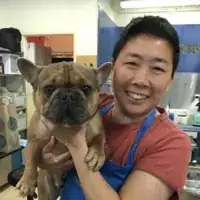 Lancy WooLancy Woo is a Certified Pet Groomer and the Owner of VIP Grooming, a pet grooming salon based in San Francisco, California. VIP Grooming has served San Francisco for over 35 years. Lancy received her pet grooming certification from the WWPSA (Western Word Pet Supply Association). VIP Grooming has been voted "Best in the Bay" in 2007, 2010, 2011, 2014, 2017, 2018, and 2019 and won Bay Woof’s "Beast of Bay" in 2014. In 2018, Lancy's work contributed to VIP Grooming's acceptance onto San Francisco's Office of Economic and Workforce Development's Legacy Business Registry.
Lancy WooLancy Woo is a Certified Pet Groomer and the Owner of VIP Grooming, a pet grooming salon based in San Francisco, California. VIP Grooming has served San Francisco for over 35 years. Lancy received her pet grooming certification from the WWPSA (Western Word Pet Supply Association). VIP Grooming has been voted "Best in the Bay" in 2007, 2010, 2011, 2014, 2017, 2018, and 2019 and won Bay Woof’s "Beast of Bay" in 2014. In 2018, Lancy's work contributed to VIP Grooming's acceptance onto San Francisco's Office of Economic and Workforce Development's Legacy Business Registry.
Certified Pet Groomer Get a washcloth wet with warm water and some tear-free dog shampoo. Gently lather the shampoo into your dog's fur and rinse it off with another clean, wet washcloth.
Get a washcloth wet with warm water and some tear-free dog shampoo. Gently lather the shampoo into your dog's fur and rinse it off with another clean, wet washcloth.
Warnings
- Keep your electric dog clippers sharp. Dull clipper blades pull on your dog’s hair and may cause discomfort. Any pain or discomfort your dog feels while being groomed may make them afraid of the clippers in the future.[23]⧼thumbs_response⧽
Things You’ll Need
- Dog brush and/or comb
- Sharp scissors
- Electric dog clippers
- Cotton balls or pads
- Dog-safe soap or shampoo
- Clean washcloths and towels
References
- ↑ https://ontariospca.ca/blog/pet-grooming-more-than-just-puppy-pampering/
- ↑ https://www.dummies.com/pets/dogs/how-to-brush-your-dog/
- ↑ https://diydoggrooming.com/grooming/face-feet-tail/
- ↑ https://diydoggrooming.com/grooming/face-feet-tail/
- ↑ https://www.aspca.org/pet-care/dog-care/dog-grooming-tips
- ↑ Lancy Woo. Certified Pet Groomer. Expert Interview. 26 February 2020.
- ↑ https://dogsbestlife.com/dog-grooming/reduce-dog-grooming-stress/
- ↑ https://www.akc.org/expert-advice/training/training-rewards/
- ↑ Lancy Woo. Certified Pet Groomer. Expert Interview. 26 February 2020.
- ↑ Lancy Woo. Certified Pet Groomer. Expert Interview. 26 February 2020.
- ↑ https://www.animalhumanesociety.org/behavior/dog-grooming-tips
- ↑ https://youtu.be/YEjPiPU-3hA?t=100
- ↑ Lancy Woo. Certified Pet Groomer. Expert Interview. 26 February 2020.
- ↑ https://www.aspca.org/pet-care/dog-care/dog-grooming-tips
- ↑ https://pets.webmd.com/dogs/guide/dogs-and-tear-stains#1
- ↑ https://www.aspca.org/pet-care/dog-care/dog-grooming-tips
- ↑ Lancy Woo. Certified Pet Groomer. Expert Interview. 26 February 2020.
- ↑ http://www.fairfieldvets.co.uk/ic/dog/amber.htm
- ↑ https://www.pets4homes.co.uk/pet-advice/how-to-wash-and-groom-a-dogs-face.html
- ↑ http://petslady.com/article/best-way-wash-dog-tips-tricks-and-hacks
- ↑ Lancy Woo. Certified Pet Groomer. Expert Interview. 26 February 2020.
- ↑ https://youtu.be/YEjPiPU-3hA?t=69
- ↑ https://petupon.com/how-to-groom-your-dogs-face/
